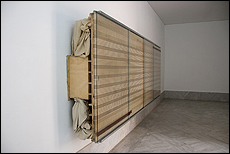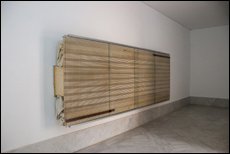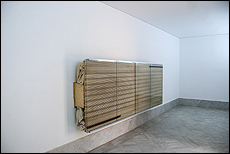![]()


THE REINHARD
MUCHA TRUST
Date: From 25
February, 2014
Place: Sala de Prioral
Bantin (2003) -entrusted to the CAAC on long-term
loan by the collector and gallerist Oliva Arauna- is one of the
unique wall sculptures devised by Reinhard Mucha (Düsseldorf, Germany,
1950). The artist began turning out such pieces, characterized by
their dual appearance of transparency and opacity, in the 1980s.
In them he uses a variety of materials, often lifted from the exhibition
venue itself or other settings, some of which tie in with recent
German history.
The plywood, screen-printed glass and different worn-looking fabric swatches that descriptively comprise this large-format sculpture serve no representational function, and they are presented to the viewer as volumetric pictures that draw on conceptual traditions and diverse reflexive experiences.
Unlike much of the artwork that came to the fore in the 1980s, Reinhard Mucha's work seems to keep its distance, enveloped in an aura of coolness. This was José Luis Brea's impression when he decided to illustrate his essay with one of Mucha's best-known pieces and invited him to participate in the seminal exhibition Los últimos días [The Last Days], held in Seville in 1992. In an article published in Issue 7-8 of the magazine Figura, José Lebrero noted how "the object acquires intensity in abandoning the purpose for which it was conceived and created" in this artist's oeuvre.
Resembling a hybrid between an inverted shelf, a bricked-up vitrine and a shuttered window, Bantin might even operate on a plane not far removed from a certain branch of abstract painting. We can also read it as an allusion to the psychology of architecture and its relationship with power, and to the museum as a self-referential entity and central cog in the process of manufacturing history.
|
ADDITIONAL DOCUMENTATION |
